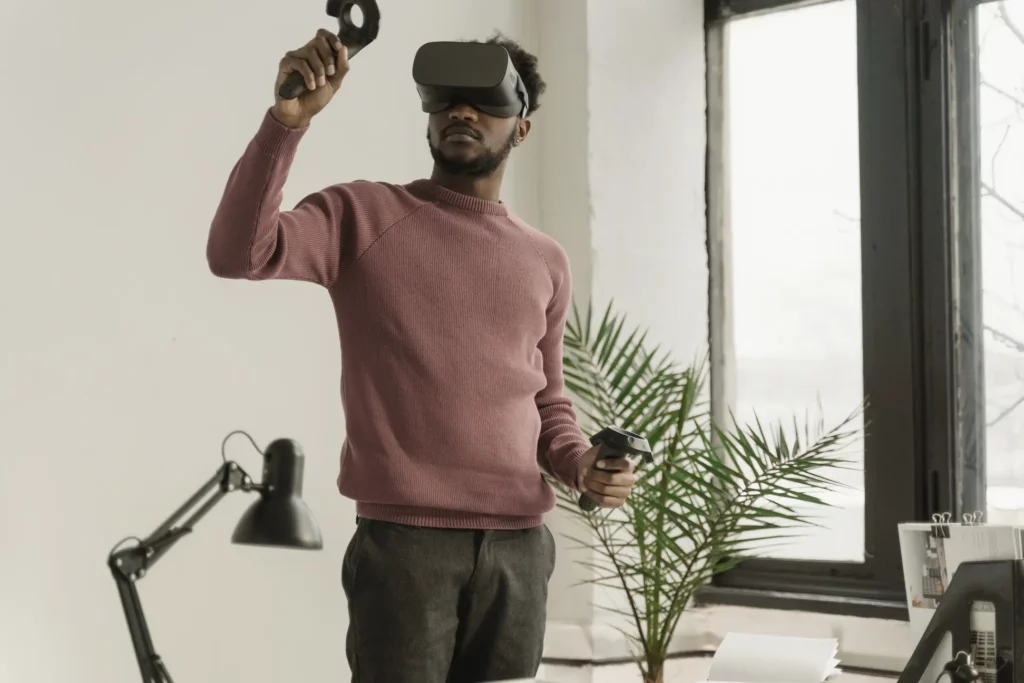Immersive learning technology has gained mass attention in recent years as it promises to revolutionize the way we learn and train employees.
But let’s start with answering the big question: what even is immersive learning?
What is immersive learning?
Immersive learning, as a concept, encompasses a range of immersive technologies that transport learners into virtual environments, blurring the lines between the physical and digital worlds. It goes beyond the limitations of conventional classroom or e-learning experiences, enabling individuals to engage in realistic, interactive, and experiential training simulations that mimic real-world scenarios. The types of immersive realities are:
- Augmented Reality (AR): Augmented Reality combines virtual elements with the real world, overlaying computer-generated images, videos, or information onto the user’s physical environment. AR provides learners with real-time information, instructions, or digital content that is superimposed onto their physical environment. In a training scenario, AR can be used to add virtual instructions on top of models in the physical world or offer real-time feedback where the AR application can detect if learners make a mistake in the physical environment and provide immediate cues via digital content.
- Mixed Reality (MR): Mixed Reality does just that — it mixes elements of the physical and virtual worlds, allowing digital objects to interact with the real environment and vice versa. This technology enhances training by providing contextual information, virtual guides, or interactive simulations within real-world settings. This could, for example, be a training scenario where learners are equipped with headsets to interact with 3D projections of machinery in their real-world workspace.
- Virtual Reality (VR): Virtual Reality creates a fully immersive digital environment that simulates a realistic three-dimensional experience, completely separate from the physical world. With the use of a head-mounted display (HMD), VR training enables employees to practice complex tasks, simulate dangerous scenarios, or engage in role-playing exercises within a safe and controlled environment. This technology is effective for training in industries such as healthcare, aviation, manufacturing, and emergency response, where practical experience is critical.
- Extended Reality (XR): Extended Reality is an umbrella term that encompasses all forms of immersive technologies, including AR, VR, and MR. XR refers to the spectrum of experiences that merge the physical and virtual worlds, creating interactive environments that can range from partially real to completely virtual.

Key benefits of virtual and extended reality in learning.
According to PwC’s Seeing is Believing report, extended reality methods—specifically VR training—will contribute $294 billion to the global economy by 2030. A 2022 study found that VR learners were 4 times faster and more focused than their e-learning peers, and 275% more confident in implementing their learnings after VR training.
Not only does VR satisfy various learning styles, but a recent PwC study found that it also minimizes distractions (after all, users are completely cut off from reality!). The benefits of extended reality in the corporate space include:
- Enhanced engagement and retention: XR can create a highly interactive learning environment, which helps employees retain information better than traditional training methods. This is due to the pictorial superiority effect, which states that the more visual the content, the more likely it is to be recalled.
- Cost savings: As XR lifts the limitations of online training, for example, by enabling hands-on experiences, and will offer more authentic, cohesive, and interactive remote and hybrid work experiences, extended reality tools can be used to train employees from practically anywhere, saving companies money on travel and other in-person resources.
- Acceleration of learning and skills acquisition
XR saves time — PwC’s research shows that what took two hours to complete in a classroom — or 45 minutes in an online learning setting — could take just 30 minutes with a virtual reality tool. It brings a whole new meaning to “This meeting could have been an email.”
- Improved productivity and security: XR can provide employees with realistic practice settings that enhance their productivity, empathy, and decision-making abilities while also keeping them safe and secure.
- Standardization: XR can ensure regulation in training, reducing the risk of errors and workplace injuries and improving overall quality and compliance.
- Learning for the hybrid, global workforce: For hybrid learners and global workplaces, XR can act as a close to real-life meeting point for people, processes, and situations spanning across geographies and time zones. Recapturing the spontaneity, interactivity, and fun of team-based working and learning, while maintaining the flexibility and convenience of working from home.
- Alleviate the shortage of talents: The Metaverse used in enterprise training can alleviate the shortage of talents by scaling resources and bringing in experts from diverse places to solve issues and provide hands-on training.
RELATED: Improve compliance to stay ahead of rapidly changing regulations

Future-proof your learning with virtual and extended reality.
Recent factors like remote work throughout the pandemic, an increasing labor gap, and the rise of a younger, more tech-friendly workforce have all contributed to the shift in XR training as a popular practice. Collaborative hybrid learning is the new normal and with XR and VR in the mix, the possibilities are truly endless. Here are some ways VR can help your team future-proof the employee learning process:
- Immersive simulations: VR technology offers hands-on experience in complex scenarios without the need for real-world equipment (i.e., construction workers learning safety techniques with a site simulation, or healthcare professionals practicing surgery on virtual patients!). This approach can save costs, reduce risk, and provide employees with comprehensive on-the-job training.
- Virtual classrooms: XR technology can help create a virtual classroom environment that enables employees to attend courses remotely while giving a higher level of interaction and collaboration.
- Training scenarios: XR technology can be used to create realistic training scenarios that simulate emergency situations, hazardous environments, or even negative customer interactions. This approach can help employees gain confidence and efficiency, leading to better performance and less workplace drama.
- Gamification: VR technology can also be used to create fun, interactive games that encourage employees to learn new skills or build on their existing knowledge. We could all use more play in our work.
Get enhanced and immersive learning with Learn365 and SynergyXR.
A prime example of the implementation of virtual reality and extended reality in learning and training management is the partnership between Learn365 (formerly LMS365), the only learning management system built directly into Microsoft Teams, and SynergyXR, the only enterprise XR platform in the world that integrates AR, VR, and MR into a single solution. SynergyXR provides organizations with a XR engine that brings training programs to life and allows L&D managers to deliver immersive and effective learning experiences to employees.
Wanna see how it works? Watch our video with SynergyXR to see how VR and other extended reality capabilities can be used in the Learn365 platform to take your employee learning to new, immersive heights!









